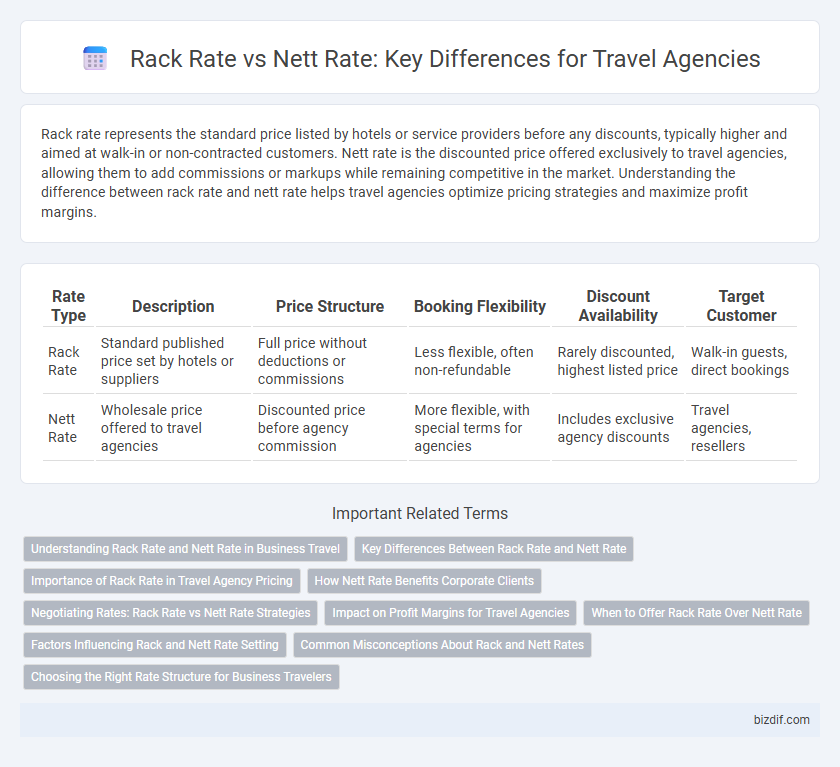Rack rate represents the standard price listed by hotels or service providers before any discounts, typically higher and aimed at walk-in or non-contracted customers. Nett rate is the discounted price offered exclusively to travel agencies, allowing them to add commissions or markups while remaining competitive in the market. Understanding the difference between rack rate and nett rate helps travel agencies optimize pricing strategies and maximize profit margins.
Table of Comparison
| Rate Type | Description | Price Structure | Booking Flexibility | Discount Availability | Target Customer |
|---|---|---|---|---|---|
| Rack Rate | Standard published price set by hotels or suppliers | Full price without deductions or commissions | Less flexible, often non-refundable | Rarely discounted, highest listed price | Walk-in guests, direct bookings |
| Nett Rate | Wholesale price offered to travel agencies | Discounted price before agency commission | More flexible, with special terms for agencies | Includes exclusive agency discounts | Travel agencies, resellers |
Understanding Rack Rate and Nett Rate in Business Travel
Rack Rate represents the standard price published by hotels or service providers, often higher to allow room for discounts or commissions. Nett Rate is the discounted price offered exclusively to travel agencies or corporate clients, excluding commissions, enabling more competitive pricing in business travel arrangements. Understanding these rates is crucial for travel agencies to optimize profit margins while providing cost-effective solutions for corporate travelers.
Key Differences Between Rack Rate and Nett Rate
Rack rate represents the publicly advertised price for hotel rooms or travel services, often higher and flexible to allow discounts, while nett rate refers to the wholesale price offered exclusively to travel agents without any commission included. Rack rates are visible to all customers and serve as a reference point, whereas nett rates are confidential and used by agencies to calculate commissions or package pricing. Understanding these differences helps travel agents provide competitive offers and maximize profit margins by leveraging exclusive nett rates.
Importance of Rack Rate in Travel Agency Pricing
Rack Rate represents the standard published price of travel services before discounts, serving as the benchmark for pricing strategies in travel agencies. This rate is crucial for transparency, enabling agencies to maintain consistent pricing structures and effectively compare competitor offerings. Understanding the Rack Rate allows travel agents to strategically apply Nett Rates, ensuring profitability while offering competitive deals to clients.
How Nett Rate Benefits Corporate Clients
Nett rates offer corporate clients significant cost advantages by providing discounted pricing exclusive to travel agencies, eliminating commission markups included in rack rates. These rates allow companies to negotiate tailored travel solutions with transparent pricing, enhancing budget control and expense management. Access to nett rates also enables corporate clients to leverage volume-based discounts and flexible payment terms, optimizing overall travel expenditure.
Negotiating Rates: Rack Rate vs Nett Rate Strategies
Negotiating rates in the travel industry involves understanding the difference between rack rates and nett rates, where rack rates represent the published prices and nett rates are discounted offers exclusive to travel agents. Effective strategies include leveraging volume bookings to secure lower nett rates, which increase profit margins without raising client prices. Travel agencies benefit from comparing multiple suppliers' nett rates to negotiate better deals and offer competitive packages while maintaining attractive commissions.
Impact on Profit Margins for Travel Agencies
Rack rates represent the standard published prices for hotel rooms or travel services, often higher than negotiated net rates, which are discounted prices offered directly to travel agencies. Travel agencies booking at nett rates can increase profit margins by selling at rack rates while retaining the difference as commission or markup. Understanding the balance between these rates is crucial for optimizing revenue, ensuring competitive pricing, and maximizing profitability in travel operations.
When to Offer Rack Rate Over Nett Rate
Offer rack rates during high-demand seasons or when booking cancellations incur significant penalties, as these rates maximize revenue without discounts. Use rack rates for last-minute bookings or premium room categories where exclusivity and flexibility justify higher prices. Nett rates work better for volume bookings or corporate clients seeking negotiated deals with transparent commission structures.
Factors Influencing Rack and Nett Rate Setting
Rack and Nett rates are influenced by factors such as market demand, competition, and seasonality, which determine pricing flexibility and profitability for travel agencies. Operational costs, including accommodation, transportation, and service expenses, directly impact the baseline pricing structure for both rates. Strategic partnerships and negotiated agreements with suppliers also shape Nett rates, allowing agencies competitive pricing to attract clients while maintaining margins.
Common Misconceptions About Rack and Nett Rates
Many travelers mistakenly believe rack rates are the best available prices, unaware these standard rates typically serve as a starting point for negotiated discounts. Nett rates, often exclusive to travel agencies and wholesalers, represent the actual cost without markups, allowing agents to offer competitive pricing to clients. Misunderstanding these differences can lead to paying higher prices or missing out on special deals and commissions offered through agencies.
Choosing the Right Rate Structure for Business Travelers
Rack rate represents the standard, published price of hotel rooms without discounts, often higher to maximize revenue from transient guests. Nett rate is a discounted price offered exclusively to travel agencies or corporate clients, providing cost savings that can be passed on to business travelers or packaged into travel deals. Selecting the right rate structure involves evaluating budget constraints, volume of bookings, and desired flexibility to ensure optimal value and convenience for business travel plans.
Rack Rate vs Nett Rate Infographic

 bizdif.com
bizdif.com